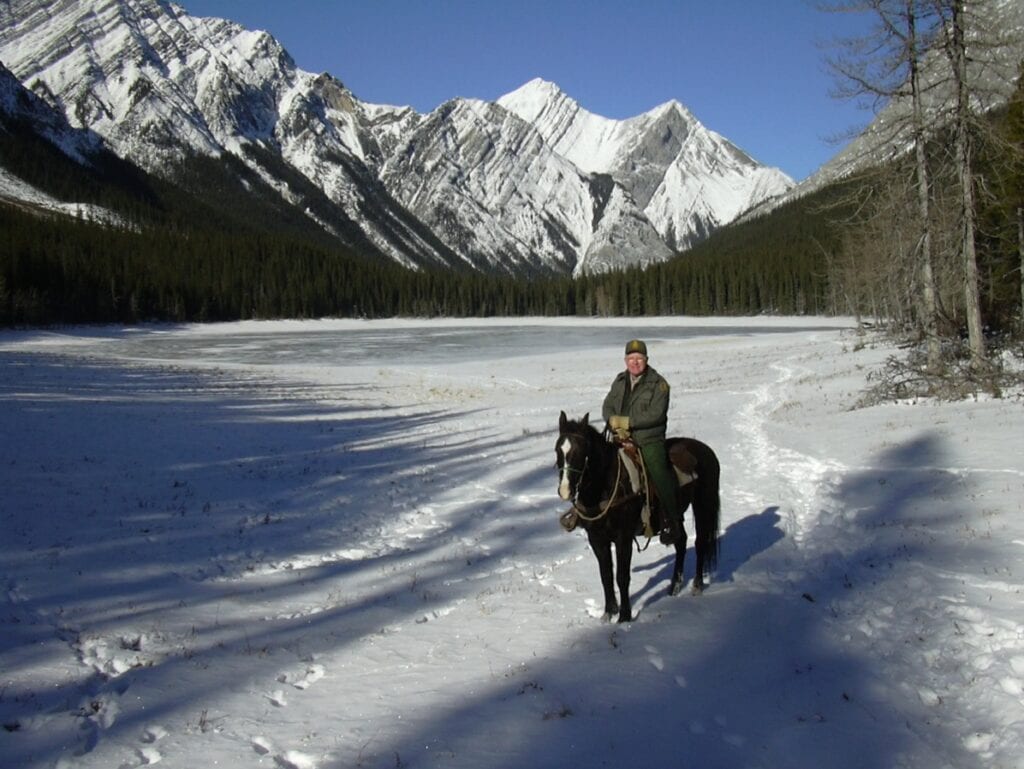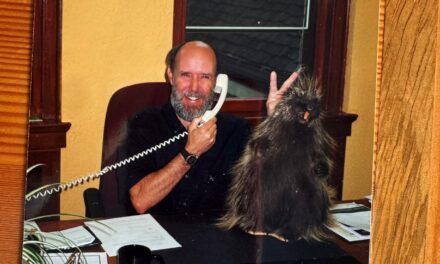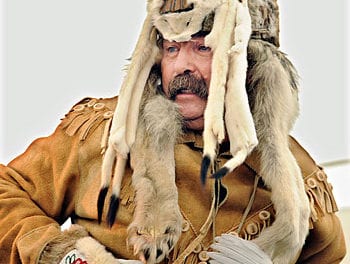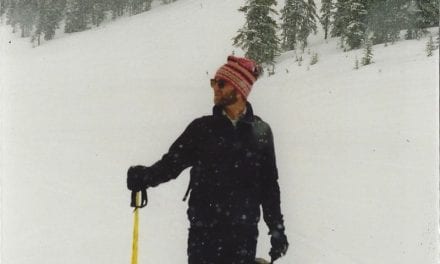Park Warden Alumni Society of Alberta Thank you to the Whyte Museum of the Canadian Rockies for granting permission to the Park Warden Service Alumni to post this interview on our website
Park Warden Alumni Society of Alberta
Oral History Project – Winter 2015
Interview with Rod Wallace
March 25, 2015

Rod Wallace on Vance at Summit Lakes in Jasper National Park
Place and Date of Birth: Calgary, Alberta. September 24, 1948.
Occupations: After completing university and traveling through Europe, Rod began his parks career in Kootenay National Park, as a naturalist. From there he moved to Revelstoke where he did historical research and avalanche work at Rogers Pass. Rod was then hired on as a seasonal warden in Waterton, a park that remains one of his favorites. Two years later he became a permanent warden and moved to Elk Island National Park, where he developed his horse skills and worked with different types of game and vegetation management. While there he continued on with his post-secondary education, completing his BSC at the University of Alberta. In 1978, Rod relocated to Jasper National Park, fulfilling his dream of backcountry life. After 29 years in Jasper, Rod retired in 2006, as the cultural resource manager for the park. It was a position that combined all his loves – backcountry travel, history and archeology.
Additional Information: Rod retired to a beautiful property on the eastern edge of Banff Park and he is actively involved in the Park Warden Alumni Society of Alberta. He will always consider himself a parks person and he continues to enjoy travelling the trails. In addition to his time in the backcountry, the many people he worked with were the highlight of his long and successful park career.
(1:01) My dad was a Saskatchewan farmer. He moved to Calgary after the Second World War. He was a veteran of the war and he spent the rest of his life in Calgary, at a spot up on the North Hill (Capital Hill), which is just north of SAIT (Southern Alberta Institute of Technology). I spent a lot of time actually in the woods around there which at that time, was at the edge of Calgary. I think I got my love of forestry and woods from what we used to call Sherwood Forest, around the SAIT site. Like I say, we were on the edge of town there so just a block or so over was a bunch of bush country, north of Calgary at the time. I spent a lot of time playing cowboys and Indians in that area. My mother was a teacher librarian and we did a lot of camping in the foothills, in Kananaskis country and in Banff and area. I think I’ve had a lifelong interest in forestry and in becoming a ranger or a park warden.
(2:35) I did a year of backpack travel around Europe between my university years and decided at that time that I wanted to make a career out of working for parks, if it was possible. I took training at university in geography and park planning. I was going to become a park planner originally, but I decided I didn’t want to be in the office. I would rather be out in the field so I kind of changed some of my course content and became one of the early university graduates in the warden service. So this was quite a significant change for myself being allowed to have a chance to work in the warden service. I think that was one of the things I found most challenging in my early days, the fact that I had university education and was introduced to parks and had to prove myself, that I could do something with my hands as well as my head. That was an era in the early 1970s where they were starting to up the education credentials for park wardens, and I was one of the early ones in that period. I often thank Jimmy Sime and Mac Elder who were on the interview board, they gave me a chance. I admitted that I liked horses, but I wasn’t an expert. I had just ridden horses as a kid a little bit, but I had an interest in backcountry and an interest in park service so they got me on and I just went from there.
“Where did you start?”
(4:33) I originally started in Kootenay. I spent a couple of summers in Kootenay and I was a park naturalist, working for Ian Jack and Larry Halverson. That was another kind of deterrent in a way, because there is the old assumption that it would be hard to make a naturalist into a warden. I actually turned down a seasonal warden offer my second year, because I felt the extra experience as a naturalist taught me about working with the visiting public as well as an awful lot about the natural resources in Kootenay Park. Then I did a winter at Revelstoke doing historical research for that area of the Selkirk and Purcell mountains. So I learned quite a bit about Mount Revelstoke/Glacier by living in Revelstoke all winter. Then I got a seasonal job offer at Rogers Pass doing the highway avalanche work that was primarily stopping traffic for avalanche control with Fred and Walter Schleiss. I learned a lot from them and all the other folks, like Peter Schaerer – people that were working in Rogers Pass at that time. So I spent two winters doing that and actually the winter before I got on as a warden I worked as a snowplow operator up at Rogers Pass. I remember Jack Willman, Mike McKnight, and Gord Peyto who were there at the time. I worked with them for a couple of winters. We could start into the Gordie Peyto stories, but I am sure you have heard a lot of those! Good guys, all of them! Did some great ski touring, and shoveled snow off backcountry cabins with Mike.
(6:23) Then from Rogers Pass, I was offered a seasonal warden job in Pacific Rim, but Larry McGuire who was the Chief Warden in Revelstoke/Glacier, said, “Oh, you better stay in the mountains. You really like that part of it, so we will send you to Waterton.” So he sent me to Waterton for a couple of years, which I never regretted. It is still probably my favorite park, because there is so much packed into such a small area. I had a real good couple of years there. They had and they still do, I guess, have an extended elk season adjacent to the park, so I was on for ten months. The second winter I was on, I got permission from Chief Warden Max Winkler to travel to New Zealand. I wanted to experience New Zealand and Australia, because like I say, I had done Europe a few years before. I went on a trip there for part of a winter and Max took me back on in the summer months. In those days you were always concerned if you gave up your seasonal position that you weren’t going to get on again, because there was such a demand for those seasonal positions. I was quite nervous about that. I actually got offered a job in New Zealand to work for the ranger service there, but I decided that I would rather come back and keep my “number”, in parks and work towards getting on fulltime. Max had a great system for training young wardens – he assigned you to work under each permanent warden for a month at a time, and learn what you could from the veterans – learn the good personal skills, and discard the bad. This system worked great, except when it came to Derek Tilson, who insisted on only teaching me how to party! Keith Brady, Frank Coggins, and Sid Mortamore were the other mentors at that time. I lived at Cameron Lake in the summer, and Red Rock canyon in the winter – and survived a winter with Bob Elliot living on KD! An International Peace Park, Waterton/Glacier, is a true World Heritage site, – will always be on the top of my list of favorite National Parks. I feel so privileged to have worked there for two years, with so many great people and cherished memories.
(7:57) I went to Elk Island as a permanent warden in 1975, or 1976 I guess it was. I spent two years there, a terrific two years there, because I worked with and learned so much from Ann and Fred Dixon, Bill and Cheryl Walburger and Monrad Kjorlien. Fred taught me, or retaught me, an awful lot about horses. He was an excellent warden especially with animals – cattle and horses before he joined the warden service – and he had quite a long and interesting career – worked with parks at the Ya Ha Tinda ranch as ranch foreman in the 1950s. Fred was kind enough to pass on so much knowledge of horses, and his incredible savvy of working with animals and horses. It was quite an experience! We even tried to herd and round up moose in those days. I got a real lesson in how determined moose can be when they get cornered. I can still see the red eyes of several moose! We had three moose running down a lane way in Elk Island, because they have an animal abattoir there, and they have many fenced enclosures…Anyway, we got the bright idea that we would try and push them into one of the pens. We got to a certain point, and then those moose just turned on us. Fred said, “Let’s get the hell out of here!” So we were full gallop to get out of there – they chased us a mile or so I guess – down and out and into an open field. It was pretty spooky. They had their heads down, and were just intent on getting us out of the country!
(10:00) I had another experience there that was kind of interesting too, because as I say we rode horses there in those days all winter long, and worked with separating, testing/tagging buffalo calves in the spring. As you know, there are both Wood buffalo and Plains buffalo at Elk Island. Again with horses one time, I was on an older mare horse moving buffalo – we got them a little too riled up. One cow charged me, and she just missed my leg, – she tried to gore the horse. She hit the rear quarter of the horse pretty hard and scarred her up. The buffalo was trying to “gut” the horse. That was pretty scary…I guess if I had been a better horseman I would have avoided her, but as you probably know buffalo are really quick when they are agitated and they don’t like being cornered ! So this cow was intent on at least getting my horse. Fortunately, it worked out okay.
(11:15) I had a really good job there actually, because I was looking after the cross country ski trails in the winter. At that time we track set a number of trails in the park and every weekend I would do the trails. Eventually I got permission to go back to university, to the University of Alberta to complete my second degree. I had a degree – a BA in planning – I had this BSC that I wanted to finish, so I took a bunch of really interesting courses. The proximity of Elk Island to Edmonton, allows you to do that kind of thing, so I took advantage of it. One winter I worked during the weekends in the park, and then I would go to school during the week. So it really worked out well, because I took courses in wildlife management from a Dr. Hudson at the time who was kind of a local expert in animal capture myopathy. We trapped elk annually there, removed their antlers and shipped them to various areas of the province. He was working on this over stressing disease that they sometimes get when they get under that kind of pressure when they are handled and moved. Again, really interesting, because I got to take part in a lot of hands-on animal work. I often remember when I first found out in Waterton that I was going to Elk Island, I thought. “Oh, I must have done something wrong?” Because they were going to send me to the prairies – to “the farm” as they called it at the time. I remember Max Winkler telling me, “You go there for a couple of years and you will learn a lot more than you will learn in other parks, just because it is so different.” You handle animals and you work with a number of different aspects of park management. I was part of a vegetation study there and archeology. We had archeologists surveying the Beaver Hills, and I worked with them which has always been one of my interests – history and archeology. It was a good learning experience and sure enough, after two years I applied to go to Jasper and I was lucky enough to actually get offered two mountain parks.
(13:35) I had a tough decision when I went to Jasper because they offered me Kluane at the same time. Wow, was that is a tough choice! I wanted to go north too. I often thought how things would have been quite different if I had. But because of my love of horses, I chose to go to Jasper, especially if I could work in the backcountry there. I wanted to do that in the worst way, so I went to Jasper in 1978. I spent 29 years in Jasper, before I retired in 2006.
(14:24) I had other opportunities now that I think about it. Bob Haney was very instrumental in trying to get me to look beyond Jasper and I remember when I went to Jasper, I said, “Oh I will spend five years here and then I will move on to another park.” But they were so good to me in Jasper. They kept moving me around to different responsibilities and I got a real good chance to work in the backcountry on a fulltime basis for three or four years as a supervisor and I just loved that! That is the thing about Jasper that is so special,- it has a great backcountry. I always have trouble trying to figure out what my favorite area is there because there was so much nice country! Those were great years. Bob had suggested that maybe I look at going north to some of the newer parks to help out with the establishment of what was at the time North Yukon Park – to establish different warden facilities in that park – it is only accessible on a six month basis because of the darkness up there, it is right on the Beaufort Sea. I chose to stay in Jasper. Like I say I was just given too many good opportunities to do what I wanted in Jasper. Thirty five years in National Parks, is just too short, to include all of the opportunities offered in working for various National Parks!




Hi Rude
Thanks for giving us a thorough synopsis of your interesting run with parks. You certainly jogged a few memories for me. I remember now of encountering you at both Rev/ glacier and Waterton in your early years. I also didn’t realize or remember that Partner became your partner. He was with a group of us on spring cleanup trip around the south in 1978 and was central in a dicey event at Isaac that should be submitted in the “Journal” section of this website.
Hi Rod.
Was nice to see Vance again. I spent 4 days with him in the Fiddle. A little unsteady on his feet but well trained. Thanks.
A friend from Waterton
Vance would tend to stumble on occasion, but only if the rider let him do so. He needed to be ridden with a gentle, but firm hand to ensure he was paying attention to the job at hand. I was fortunate to be given the horse as a four year old & worked with him while stationed at Pocahontas. He was ridden on patrol in the campground many times, as well as in the Fiddle for many years on ten day backcountry patrols. Frequent day trips were also made in all areas of the of the district & with F & W officers adjacent the Park. One of the truly great & versatile working horses of the Warden Service. RIP ol’ buddy.